SFF computers are not a new thing at Bjorn3D. However, Biostars iDEQ model 200A may very well be the best executed, P4-based SFF system out there.
Introduction
First off, let me say that this is far from my first MiniPC or Small Form Factor (SFF) PC. My first, modern SFF PC was a good, old Intel i810E based Book PC. I still have it, and it works great for what it is. After that, Ive gone through so many iterations of NLX form factors, several FlexATX barebones systems and custom systems, and more than my fair share of small MicroATX cases and motherboards. My attraction to the SFF market has always been because Ive been attending/hosting a LAN party since around 1995 and no one likes dragging a full tower, steel ATX case around. SFFs typically offer enough for a LAN gamer: onboard audio, video and networking, besides the small size. Lately, weve seen a great increase in offerings of these devices and many of which offer the power potential of any full sized system. The model Im reviewing here, Biostars iDEQ model 200A, may very well be the best executed, P4-based SFF system out there.
Specifications
ATI Onboard! |
Yes, the iDEQ 200A model uses ATI’s RS300 (or Radeon 9100 IGP) + iXP150 chipsets, giving the user Radeon 9100 onboard graphics capabilities. It’s *only* DirectX8.1 compatable but it does provide a level of integrated performance which should yield excellent multimedia performance and usable gaming performance. |
Beyond this highlighted feature, the iDEQ 200A offers:
- CPU: The iDEQ 200A is an Intel Pentium 4 based system.
- Memory: There are two DDR memory slots which function in dual channel mode. Up to 2GB of PC3200 are supported.
- Expansion Slots: As is, thankfully, typical of most SFF systems these days, there is one AGP8x slot and 32-bit PCI slot.
- I/O Ports: Four USB2.0 ports (two front & two back),
2 S/PDIF audio ports (one front and one back),
mini-DIN audio in/out ports on the front & back (microphone and headphones on front and typical mic/in/out on back via Realtek ALC655 chipset).
Also on the back are 2 firewire ports (VIA VT6307),
1 VGA port (no DVI),
1 ethernet port (Realtek RTL8100B 10/100),
keyboard/mouse PS/2 ports,
and 1 serial port.
My only real gripes with the system are with the ports selection. I’d like to see 4 USB2.0 ports on the back and I actually miss a good, old LPT port. There is certainly enough real estate for the ports. - IDE: UDMA 33/66/100 devices are supported.
- Serial ATA: Yes, two SATA devices are supported.
- Expansion: 1 external 5.25″, 1 external and 1 internal 3.5″ drive bays.
What really isn’t mentioned above but is noted in the packaging of the unit is that the 200A is the first SFF system to support Intel’s Prescott P4s right out of the box! We’ll take advantage of that fact in the performance review on the next page.
Packaging
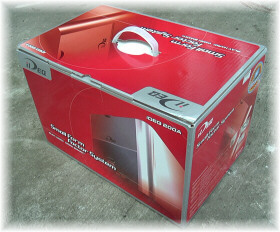 |
The packaging is your A-typical box. It does come with a handy, dandy carry handle. Note that several retailers offer Biostar’s SFF carry bag for free with an iDEQ purchase…a nice touch. Since this is a review item from Biostar, we did not have immediate access to the carry bag. |
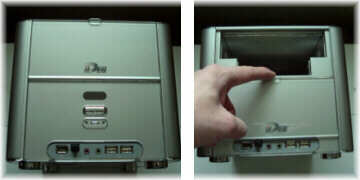 |
The iDEQ 200A features a sliding front door, covering the two external drive bays. The composition of the front is plexiglass or lexan with an undercoating of silver coloring. This provides a nice durable surface for desktop duty and retains a nice gloss finish. The bays ship exposed, as shown in the picture, but blank covers are provided. The remaining construction is aluminum. |
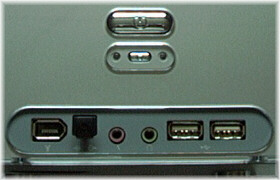 |
Below the drive bays are the power button (at top), small reset button which is strattled by power and HD LEDs. At the very bottom are the front IO ports. Left to right we have the firewire port, S/PDIF I/O, microphone, headphones, and the two USB2.0 ports. |
 |
The back panel is nicely arranged and not crowded. The power supply, as can been seen at the top, is a long flat unit. The case fan is an active part of the CPU ansd system cooling, which I’ll discuss further later on. The I/O ports section at the bottom is nicely color coded and labeled with easy to see pictures (unlike some models offering only the slightly stamped tin back I/O plate). The two slots for the AGP and PCI slots are visible at right. They use the ever increasingly popular external mounting tab that hinges about 1-inch above the screw mount. This is actually a necessity because open space offered by the hinge is necessary to angle-in PCI and AGP cards. |
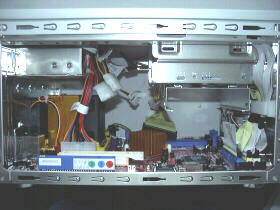 |
The left side of the open case (both sides and the top panel remove independently via included thumb screws) gives a broad angle shot of case layout. The most obvious conclusion one should draw when first looking at this picture is how open the case is. Biostar has done a bang up job of tucking wires into plastic clips and running then in un-obtrusive locations along the front of the PSU and up the front edge of the case. The cables were, thankfully, preinstalled and labeled. Even the molex power plugs are labeled since the loose lengths of wire are limited. Another thing to note here is the sideways HD caddy. |
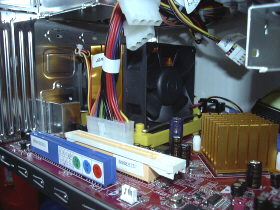 |
This second shot, also from the left side, shows the PCI and AGP slots. Note that the AGP slot uses one of the sliding locks, which are much easier to work with. A sizeable anodized heatsink can been seen on the ATI chipset. |
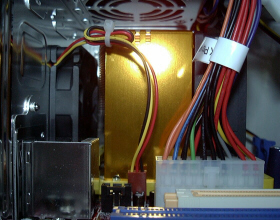 |
Looking more closely at the heatsink arrangement, you’ll note that while the CPU uses a full 80mm x 25mm fan, the case fan is a thin 15mm version that draws from the CPU. This setup results in a dual fan duct through the heatsink. Both fans are thermally monitored with the speeds being auto-adjusted by Windows. |
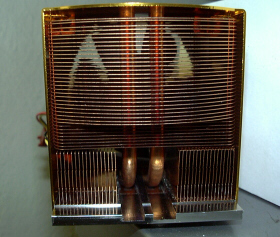 |
Looking at the heatsink, out of the case, shows that it’s a full copper heatpipe arrangement. The very thin copper fins are nicely stacked vertically. Not shown in these pictures is the heatsink retention mechanism. It works just like the CPU ZIF socket in that the heatsink is simply plopped into a plastic recessed area and a single lever is bent down and clasped to secure the heatsink to the CPU…very nice and simple, and much appreciated. |
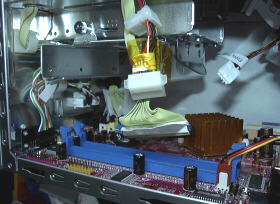 |
The right side of the case provides access for the memory slots and the HD caddy. The HD tray rides on rails and is easily removed by the one thumb screw. The whole top tray, for the external drives also removes from the top of the case so that they can be more easily installed from outside of the case. Right in the middle of the screen are the IDE and power cables, dropping down from the top of the case. Installing and swapping HDs is a breeze. The memory slots are easily workable too. They’re unhindered by the surrounding case. Note the 3-pin power lead at bottom right. This is for the heatsink fan. My ONLY gripe with the whole installation process was the removing and replacing of the heatsink. It is a tight fit over a couple capacitors, and you need to hold the power cable in one hand while to lock the heatsink in place because the heatsink locking lever would otherwise pinch the fan power cables. |
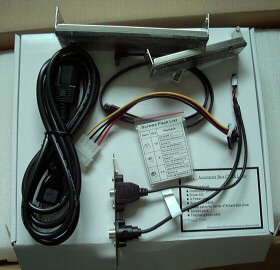 |
The extras…as mentioned before, the packaging includes blank face plates with matching front face finishes. A power cord, molex to serial ATA power adapter, one SATA drive cord, and TV-out cable round out the packaging. The TV-out requires the use of one of the card slot holes, unfortunately. But it does offer both RCA and S-Video ports. Also included is a nicely prepared paperback manual and driver CD, as well as a baggie of screws. |
Next page…performance testing and conclusions.
Performance
We considered comparing the onboard video performance of the iDEQ 200A’s Radeon 9100 IGP to Intel’s “Extreme Graphics” but quickly realized that it would be a waste of time. It is well documented that Intel’s embedded graphics solution is to be considered marginal, at best. However, I will say that Intel does a pretty good job with compatability in their video drivers. Besides that, Biostar was touting the 200A as being the first SFF that is “Prescott Ready,” so I felt it was worth investigating this aspect. Therefore, I threw every socket 478 CPU I had at this thing, without any BIOS flashes, to see what would happen. I tested three CPUs: Intel Celeron 2.0GHz (400MHz FSB, 128KB cache), Pentium 4 2.4GHz (2.4B, 533MHz FSB, 512KB cache), and finally a Prescott 2.8GHz (2.8E, 800MHz, 1MB cache). To round out the system, I have a Western Digital 160GB/8MB 7200RPM ATA100 hard drive, and two sticks of Legacy PC2700 (333MHz) 512MB DDR. Yes, the iDEQ 200A does support DDR400, but my two sticks of Corsair XMS PC3200 512MB wouldn’t POST (a small blemish on this otherwise shining system).
For testing, I’ve looked at 3DMark2001SE, Comanche 4 benchmark, and a few Sisoft Sandra 2004 tests. Note that the BIOS was set to use 128MB of system memory for the video duties (128 being max).
But, before we look at the bench tests, let me talk a little bit about the BIOS and how well the 200A recognized my hardware…especially the Prescott. I first tried the Precott CPU and, sure enough, the Biostar booted and posted correctly. To be honest, I wish MORE manufacturers followed Biostar’s lead in how they have their Phoenix BIOS set up. The iDEQ 200A’s POST screen is full-featured and rich with information. First off, you get a nice list of the processor ID, including FSB and multiplier, as well as the memory speed and drives detected. To boot, pun intended, the BIOS gives you three options: F1 – continue, F8 – enable system configuration, and F9 – select boot device. Oh boy, if every system I worked on had those boot options, I’d be a lot happier person. Beyond this great boot screen, the BIOS is well laid out. Overclocking features are limited to some voltage enhancements as well as some FSB (frontside bus) and memory frequency boosting. Both the memory and FSB can be raised up to 15MHz over stock, in 1 MHz increments. A reasonable amount but maybe not enough for some power users.
Comanche 4 Demo
Comanche 4 is a very CPU intensive benchmark, which is why I chose it for this scaling test on the iDEQ. Its DirectX 8.1 engine is ideal for the onboard Radeon also. I tested the system at resolutions ranging from as low as 640×480 (32-bit colors and DX8 hardware enabled) and all the way up to 1600x1200x32. I also tested with and without anti-aliasing. Anisotropic filtering was set to 2x in all tests.
|
|||||||||||||||||||||||||||||||||||||||||||||||||||
It really didn’t come as quite a shock to me to see such low scores across the board. Comanche 4 is a brutal engine. However, the scores show us two important things. The game engine is very CPU dependent, as shown by the P4 2.8E besting the Celeron 2.0GHz by roughly 300%. It’s also VERY important to note that any and all onboard video chipsets are completely dependent (and hindered) by the use of the system memory. System memory, relatively speaking, is s-l-o-w. We’re not talking 900MHz DDRII here. I’m certain these scores would be somewhat better if my DDR400 had worked. Also note that the P4 2.4/533 posts strikingly higher values than the Celeron. There’s a lot to be said for gaming with the un-crippled P4 core. There isn’t however, that big of a performance difference between the 2.4 and 2.8E though. The HyperThreading, FSB boost, and extra cache aren’t helping much here.
3DMark2001 SE
3DMark2001 SE is aging, but it’s an appropriate benchmark for DX8 class systems of this caliber.
|
|||||||||||||||||||||||||||||||||||||||
|
|||||||||||||||||||||||||||
Well, at least 3DMark2001 SE is posting slightly more usable scores on even the Celeron processor. Without anti-aliasing, even the Celeron posts numbers above 2500 which is a reasonable lower limit for any sort of acceptable gaming. Even at 1600×1200 the Celeron is still above 2000 with the Radeon 9100 IGP. Also noteworthy is that the P4s aren’t getting the +300% performance gain over the Celeron. I believe we’re seeing more efficient use of the onboard GPU here. Anti-aliasing is another story. Just like we saw in Comanche 4, the AA scores are dismal. But, AA was more feasible at lower resolutions like 800×600.
SiSoft Sandra 2004
I used Sandra to look at some more generic system performances. The most significant results that I saw were with the cache and memory test:
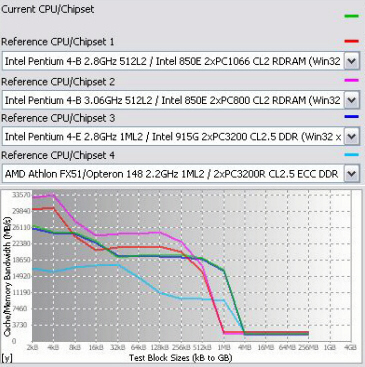
The graph, above, shows the scores of the iDEQ 200A (in green) versus several other stock benchmark scores. Of note here is how well the iDEQ, with 1GB of CL2.5 PC2700 and the 2.8E, tracks almost identically with an Intel 915G-2.8E-PC3200. Apparently, the Radeon chipset used in the iDEQ does a handy job of cache and memory handling.
I also ran Sandra’s CPU and CPU Multimedia benchmarks:
|
|||||||||||||||||||||||||||
|
|||||||||||||||||||||||||||
Under both tests, we clearly see a progression in performance increases from the Celeron 2.0GHz up to the P4 2.8E. Where we see the big changes is in the floating point portions of the tests. Notice how the 2.8E is providing a nice jump over the other processors in the FPU tests. I’d imagine we’re finally seeing more of the benefits from the 800MHz FSB and larger cache in these instances.
Conclusions
Like I mentioned, I’ve used my fair share of SFF systems, and I’ve found the Biostar to take top honors when mentally compared to the others that I’ve played with. First of all, and not previously discussed herein, the Biostar iDEQ 200A uses software to track the system temperatures and actively adjusts the fan speeds accordingly. In my experience with it so far, I’ve barely noted the fans running over a whisper speed. When you first get Windows running and get the driver CD loaded, Biostar asks you to run a small application that sets up this active monitoring. It whirls the drives at varying speeds and samples temperature changes or other tech goodness. It then uses that baseline to govern how it speeds the fans during use. When you turn on the 200A, you’ll get a very short, loud whirl of fans. It then promptly reduces to a whsiper, and the system continues to boot. In all the benchmarking and game playing that I’ve done, I never heard the 200A reach that boot-up level of noise….wonderfully done, Biostar.
The second reason that I liked the Biostar so much is the system layout. The memory slots don’t interfere with the AGP slot, capacitors are out of the way. Drive access is top notch. It is a well thought out system. And, the last reason why I appreciate the 200A so much is the full featured BIOS with Prescott support right out of the box. Maybe it lacks some of the overclocking potential that some may look for, but the quality of what is there is enough for me.
In the end, it was very easy for me to give Biostar’s iDEQ 200A a 9.0 out of 10.0 score and the Bjorn3D Golden Bear Award.
 Bjorn3D.com Bjorn3d.com – Satisfying Your Daily Tech Cravings Since 1996
Bjorn3D.com Bjorn3d.com – Satisfying Your Daily Tech Cravings Since 1996



